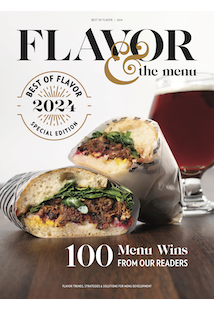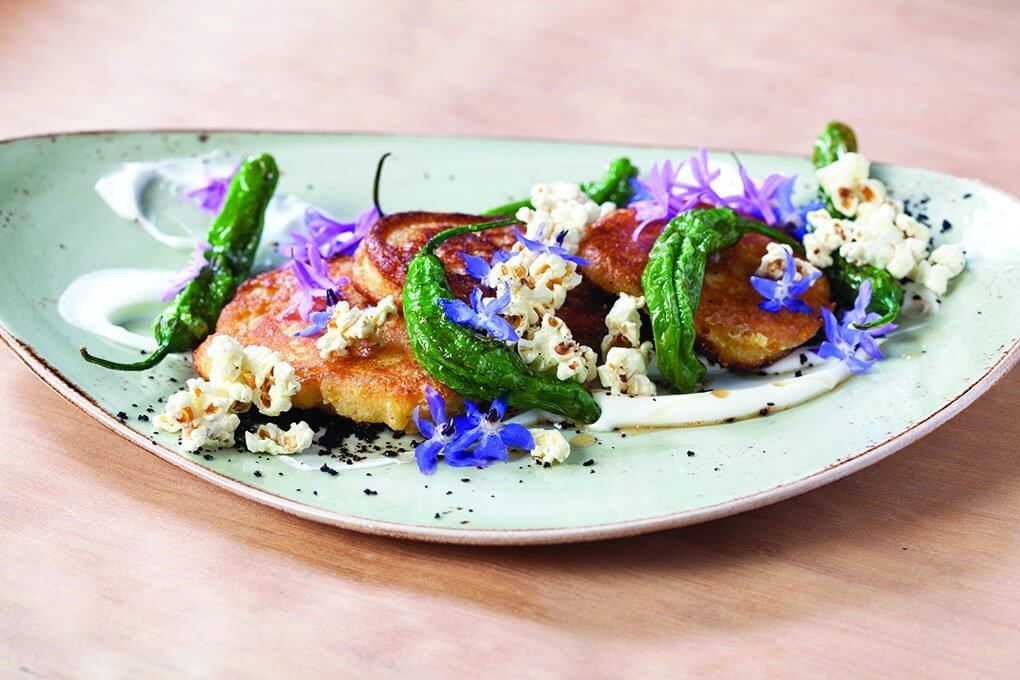Of the handful of trends that drive innovation in foodservice, none has changed the way we eat to a greater degree than “dining casualization.”
What began as the upstreaming trend around the turn of the millennium, where upscale ingredients began to enter the mainstream and trickle into the lower dining segments, casualization has morphed the foodscape into one where fine-dining caliber cuisine is enjoyed at communal tables in cinder-block buildings, consumers are happy to purchase their meals at curbside from a food truck, upscale ingredients have become fast-casual sandwich components, and by my own count, the number of restaurants in New York City that still require a gentleman to wear a jacket has dwindled to nine.
It is against this backdrop that The Culinary Institute of America in St. Helena, Calif., held its most recent Worlds of Flavor conference, entitled “Casual by Design.” The event featured more than 70 chefs from the United States and abroad who are defining the next wave of casual cuisine, and whose demonstrations and tastings provided many clues to the future direction of American menus.
One theme that became evident early in the conference was the ongoing influence of global cuisines on casual menus, both in their authentic forms and in increasingly creative culinary mash-ups.
In his opening address, Singaporean street-food expert KF Seetoh discussed the anticipated arrival of Asian hawker-style street food in the United States via Anthony Bourdain’s upcoming market in New York, and the potential it has to not only transform the way Americans think of street food, but create demand for that style of cuisine across the country.
“Food halls in America pale by comparison,” he said, describing the hawker stalls as a singular experience that combines “live culinary performance art with worry-free dining. No worries—no reservations—not even a menu!”
He explains that each hawker specializes in only one dish, resulting in an uncomplicated ordering process and cooking that is executed at high levels of quality and consistency. Seetoh believes that if Bourdain is able to bring his vision to fruition, hawker cuisine could be a “game-changing influencer” on the future of casual dining in America.
Latin Flavors from Peru to Portugal
The diverse cuisines of Spain, Portugal, Latin America and the Caribbean provided attendees with extensive ideas for new menu applications.
The live demonstrations and tasting menus of Tijuana, by Javier Plascencia, chef/owner of Misión 19 in Tijuana, Mexico, were entirely devoted to aguachile, the classic Mexican citrus-marinated seafood dish he described as a “spicier, more complex version of a Peruvian ceviche.” The traditional shrimp version he demonstrated was a graduated build of salted shrimp tossed with lemon, lime and shaved red onion, folded into a combination of garlic, jalapeño, chiltepin peppers and salt that had been macerated in a molcajete.
He then created a non-traditional Carrot Aguachile, marinating shrimp and sea urchin in carrot juice, citrus, lemongrass and ginger, and topping the dish with shavings of cucumber, kumquat and carrot. During the tasting sessions, guests were also treated to a Kampachi and Asian Pear Aguachile and a Cilantro-Lime Scallop Aguachile “Shot.”
Plascencia asserted that, given the mainstream popularity of ceviches and seafood crudos, along with the explosive growth of poke dishes on menus, expanding bold and fresh flavors on American menus with aguachiles is a solid opportunity.
Corn masa
Barbara Sibley, chef/owner of La Palapa in New York, conducted a session highlighting the many uses for corn masa on the menu, demonstrating techniques for creating sopes (molded masa corn cups, steamed and filled with various meats and vegetables), doraditas de masa verde (fried, cheese-stuffed pockets of masa turned bright green by replacing the water in the masa dough with cactus purée), and chileatole (a rich chicken soup flavored with fresh green chiles and thickened with masa purée).
The Panucho
Joe Hargrave, founder and CEO, and Sara Deseran, marketing and branding director for Calif.-based Tacolicious, demonstrated another Latin masa-based specialty: the panucho, a puffed masa tortilla stuffed with refried black beans and topped with achiote-marinated pulled turkey, cabbage, avocado and pickled onion.
More clever Latin mash-ups
Clever Latin mash-ups were also featured during the tasting sessions, such as: the Merguez Corn Dog with pistachio romanesco and mint yogurt, put forward by Ross Melling, chef de cuisine at Bouchon in Yountville, Calif.; a tamale created by Claud Beltran, executive chef/owner of Claud & Co. in Pasadena, Calif., stuffed with Spanish longaniza sausage; and Grilled Octopus with Curry and Coconut Milk, from Elena Hernández, chef/owner of St. Francis Café & Market in Panama City, Panama.
While Latin foods are already popular with American consumers, these concepts show that there are still many opportunities to create unique offerings that lead to further menu differentiation.

Pupusas introduce a newer menu application of Latin flavors
The Asian Influence
The Latin sessions of the conference were interesting and idea-filled, but it was the Asian chefs who stole the global stage. In sessions with titles such as “China in Motion: Tradition Meets Casual Fusion,” and “Blending French Techniques with Chinese and Korean Cooking,” Asian-influenced mash-ups were a particular focus, producing an amazing array of creative new global flavor combinations.
These mash-ups at times transcended the expected crossovers with Latin and European ingredients, and included combinations of various Asian cuisines. Two Chinese mash-ups of the popular Japanese savory custard dish chawanmushi were prime examples.
A crowd favorite at the first tasting session was Hong Kong-based chef Chong You Chan’s preparation of Steamed Water Curry Egg, an umami-rich custard composed of beaten eggs blended with water, curry, fish sauce and bits of barbecued pork, which Chan steamed in small metal cups and garnished simply with shreds of pickled daikon.

Intriguing Asian offerings included the Steamed Water Curry Egg from Chong You Chan, president of the Society of Chinese Cuisine Chefs in Singapore. The custard-like dish is sprinkled with barbecued pork.
Jonathan Wu, chef/partner of Fung Tu in New York, demonstrated his signature dish of China-quiles, which he describes as “chawanmushi meets chilaquiles.” Instead of using a traditional dashi to flavor the custard, Wu combines an intensely reduced smoked chicken stock and white soy sauce with the beaten eggs and steams a one-inch layer in a shallow bowl. He then tops the custard with “Chinese Bolognese,” a rich ground-pork ragu flavored with spicy Korean gochujang chile paste. Tortilla chips are replaced with freshly fried yuca root chips, and the dish is finished with a blizzard of chopped mint, scallion tops and cilantro.
Wu’s China-quiles are wildly craveable, but by no means subtle. He describes his cuisine as “playful Chinese New York food,” which frequently plays off of the “Chinese flavor triad of salt, fat and sugar.”
Junghyun Park
A more restrained approach is taken by Junghyun Park, chef of Atoboy in New York, a highly acclaimed restaurant that offers an extensive menu of contemporary banchan-style dishes intended for sharing. Park demonstrated a variety of the restaurant’s favorites, beginning with Sunchoke and Oyster Mushroom, featuring slices of dashi-braised sunchokes and sautéed mushroom topped with tiny cubes of orange, shreds of scallion and napa, and a drizzle of creamy white truffle sauce.
Park then prepared his Korean Beef Tartare, unique in that the beef is cut into a fine julienne rather than chopped or cubed, which he folds with fermented radish, tops with crispy potato shreds and encircles with oyster cream sauce. Uni, or sea urchin roe, is a favorite ingredient of Park’s, and he featured it in both a nigiri-style presentation of Seaweed “Gim” Rice, formed into fingers and topped generously with lobes of uni, and a dish of Cured Fluke with uni, fermented turnip and yuzu.
Casual Asian sandwiches
Creative twists on casual Asian sandwiches were another conference highlight. Bill Kim, chef of Chicago’s Belly Q and Urbanbelly, prepared two favorites from the latter: a marinated and grilled Lemongrass Chicken Sandwich garnished with toasted peanuts and coconut sambal, and an Asian Pork Meatball Sandwich topped with curry mayonnaise, pickled papaya and chile-spiked somen noodles.
Vietnamese banh mi Filipino mash-up
King Phojanakong, chef/owner of Kuma Inn in New York, presented a Filipino mash-up of the Vietnamese banh mi, filled with duck confit in adobo sauce, jalapeños, pickled daikon, cucumber and a spicy siling chile mayo.
Chicken kebab sliders
Maneet Chauhan, co-owner/executive chef of Chauhan Masala & Ale House in Nashville, pushed the envelope even further with her signature Malai Chicken Kebab Slider. She blends ground chicken and cream cheese with grated ginger, mint, cilantro, masala powder and dried fenugreek, which she forms into patties and grills. The sliders are built upon butter-toasted, onion-seeded brioche rolls slathered with sour cream and mango ketchup, the patties adorned with shredded pickled apple and jalapeño. Not a surprise that attendees universally raved about these tiny flavor bombs.
As chefs increasingly shake up the global larder, inspired flavor treatments such as these are truly representative of the next wave in casual cuisine.
American Southern Cuisine: What’s Next?
A host of chefs from all corners of the American South were assembled at the conference to not only highlight the foods and flavors of their respective regions, but to provide their perspectives as to the future direction of this most beloved of American cuisines.
The group was led by writer and producer John T. Edge, who is also the co-founding director of the Southern Foodways Alliance, an organization dedicated to studying and documenting the evolving cuisines of the country’s Southern regions.
In his opening talk, Edge stated that as the South continues to resolve its history of tragedy, its cuisine is entering a renaissance, with a rapidly growing number of American chefs and dining consumers alike showing keen interest in the pleasures of Southern cooking.
“The South is America’s front porch,” he said, “and our food tells the stories about our many regions.” Edge believes that the future lies with a new cadre of chefs that are “bulldozing the expected, while retaining tradition.”
Michael Fojtasek
When asked what he believes is next, Michael Fojtasek, executive chef/owner of Olamaie in Austin, Texas, said, “We are exiting the ‘technique-driven’ era and entering one that is driven by product quality. We’re past the point of seeing how many tricks we can put on a plate. Artisan-quality ingredients are making their way onto casual menus. They are no longer simply for fine dining.”
Fojtasek cited American country hams as an example of this artisanal movement. “Our best country hams rival any of the products coming out of Italy or Spain,” he said. “Talk about artisan quality—when you call these producers to place your order, many times the person answering the phone is the same person who makes the ham.”
During one of the seminar breakout sessions, Fojtasek hosted a tasting of country hams from three different producers; the hams ranged in age from eight months to two years. A single taste provided validation of his assertion regarding the flavor and quality of these hams. The chef also interjected a “what’s next?” regarding the future of these products.
Several of the producers have begun holding back some of their inventory and aging them for additional years, to create “super-premium” country hams, reserved exclusively for their best restaurant customers.
The tasting sessions provided numerous examples of skillfully prepared Southern classics, with an equal amount of dishes that were clearly “bulldozing the expected.”

Attention to detail is paramount to Foreign & Domestic’s Ned Elliott
Following traditional lines, Fojtasek served a Carolina Gold Hushpuppy garnished with 18-month aged country ham and black walnuts soaked in Wild Turkey, and an Olamaie Deviled Egg with creamed yolk, pickled mustard seeds and smoked pepper. And Brooklyn-based Carolina pitmaster Elizabeth Karmel wowed attendees with a Sweet Potato Bourbon Mash topped with her signature Sugar & Spice Pecans.
Then many of the “new cadre” Southern chefs brought out their bulldozers, including Atlanta-based chef Eli Kirshtein, who served Blackeyed Pea Falafels with benne tahini yogurt, and a 26-hour smoked brisket and root vegetables served with latkes and charoset, a coarse fruit-and-nut paste traditionally served at Passover.
Ned Elliott, chef/owner of Foreign & Domestic in Austin, Texas, served Morels and Pickled Ramps with “scrambled eggs” that were emulsified and dispensed as a light chiffon from a nitrogen charger, and a delicious combination of Pickled Corn Pancakes with maple buttermilk and blistered shishito peppers.
The true showstopper was the Kerala Fried Chicken demonstrated and served by Asha Gomez, another Atlanta-based chef, who until recently helmed Spice to Table. Gomez uses strictly boneless, skinless chicken thighs for her fried chicken, which are marinated at least 24 hours in her signature “green brine,” a purée of garlic, ginger, Serrano and jalapeño peppers, cilantro, yogurt and “lots of salt.” The thighs are tossed in unseasoned flour, fried to a crispy crunch and finished with a drizzle of coconut oil. The result is a truly singular fried chicken with nearly endless depth of flavor and a challenging amount of heat.
Veg-Centric Cuisine
As the trend has been covered extensively in these pages over the last three years, it was of particular interest that vegetable centricity was a significant callout of the conference. Not only was one of the event’s decorative banners adorning the main entrance for the event emblazoned with the words “Veg-Centric,” a significant portion of the World Marketplace tasting room was devoted to chefs serving dishes that reflect the principles of vegetable centricity.
The defining aspect of veg-centric cuisine is the judicious incorporation of meat and seafood proteins in produce-based dishes, the goal being to increase the richness and flavor complexity of the dish beyond what could be achieved simply with plant-based ingredients.
The number of umami-rich protein “adds” in these dishes continues to expand as more chefs adapt this style of cooking, and include boldly flavored sausages such as Portuguese linguiça and Chinese lap cheong, cured hams including Ibérico, prosciutto and American country hams, meat ragouts and broths, anchovy, bonito flakes and fish roe.
This practice results in dishes that are not vegetarian or vegan, and are not targeted at those niche groups, but rather the vast number of omnivorous consumers. And while a few of the dishes featured in the Veg-Centric tasting area were meatless, craveable plant-based dishes featuring creative protein additions were an easy find.
Highlights included John McConnell’s Roasted Beet Tartare Crostini topped with sturgeon caviar; Jonathan Wu’s Fava Bean Curd Terrine with bacon and chile oil, Katianna Hong’s (Meadowood, St. Helena, Calif.) Tartine of Green Garlic, Spring Peas and Lardo; and Michelle Minori’s (Barzotto, San Francisco) Belgian Endive with Pasta Pearls, Tuna Conserva and Bottarga.
 Culinary Institute of America
Culinary Institute of America José Chesa of Chesa in Portland, Ore. seasons asparagus
Out of the Compost Bin, Onto the Plate
Another cooking technique that received attention was “root-to-stem” which involves utilizing every part of a vegetable or fruit that can be made edible in an effort to maximize yield and reduce waste.
Jehangir Mehta, chef/owner of New York-based restaurants Graffiti, Me and You, and Mehtaphor, demonstrated several of these techniques, creating an Eggplant-Filled Steamed Bun garnished with pickled cauliflower scraps and crispy chips made from the eggplant skin, and a Garlic Coconut Soup based on a stock made from a random assortment of vegetable trimmings, including broccoli stalks and tomato pulp. Mehta observed that the flavor of a stock made in this way will vary widely depending on the ingredients, and requires creative spicing and seasoning to create balance.
Mehta also displayed an infused vodka made with the skins and membranes of juiced oranges, but the most creative root-to-stem technique belonged to Maxime Bilet, co-author of The Modernist Cuisine series, who made shot glasses for serving his French Onion Essence from onion skins that were compressed into a glass shape and baked with an acrylic coating.
The most positive effect of dining casualization has been the vast increase in the availability of higher-quality foodservice meals throughout all of the commercial segments. If the conclusions reached at the conference regarding future directions hold true, dining consumers can expect to benefit from a growing commixture of global ingredients on the plate, further innovation of produce-based dishes beyond vegetarian and vegan, and a continued rise in the appreciation of traditional American cuisines.










